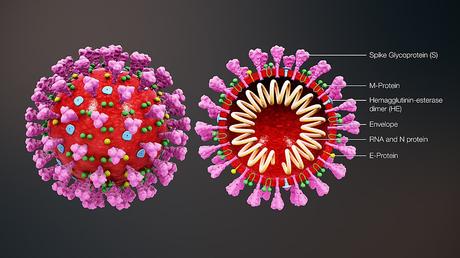The key difference between coronavirus and SARS is that coronavirus is a large family of positive-sense single-stranded RNA viruses while SARS is a serious form of pneumonia caused by a distinct species of coronavirus named SARS-CoV.
Coronaviruses are a large family of single-stranded RNA viruses. They transmit between animals and people. They infect the respiratory system and cause illnesses ranging from the common cold to serious pneumonia. SARS is a disease caused by a coronavirus species named SARS-CoV.
Coronavirus is a large family of enveloped viruses with helical-shaped nucleocapsids. Coronaviruses cause illnesses ranging from common cold and pneumonia to severe acute respiratory syndrome (SARS) to the Middle East respiratory syndrome (MERS) to COVID 19. These viruses infect the respiratory tract of mammals, including humans. People of all ages are susceptible to this virus. The common symptoms of coronavirus infection are runny nose, cough, sore throat, and headache.

There are different types of coronavirus. Generally, coronavirus can be transmitted from animals to humans. When people have weakened immune systems, this virus spreads from person to person through droplets carrying the virus.
Therefore, touching or shaking hands with an infected person, making contact with the objects having the virus, etc. can cause the spread of the virus. Hence, in order to prevent the spreading of this virus, it is necessary to take precautions such as wearing surgical face masks, washing your hands using soap for at least 20 seconds, and avoiding close contact with infected people.
What is SARS?
SARS or Severe acute respiratory syndrome is a serious respiratory disease that emerged in 2002 from China. It is a serious form of viral pneumonia caused by the coronavirus species named SARS-CoV. SARS-CoV is an enveloped virus containing a positive-sense single-stranded RNA genome. However, SARS-CoV2 is not a direct descendant of SARS-CoV.
SARS disappeared in 2004, after making more than 8000 people sick and 774 deaths. SARS-CoV infects humans, bats, and certain mammals. Similar to coronavirus disease 19 (COVID 19), SARS was an outbreak of severe respiratory disease across the globe. After 2004, no SARS patients have been recorded until now. But in 2012, a new coronavirus emerged and caused Middle East respiratory syndrome (MERS), which was an illness similar to SARS.
SARS-CoV viruses mainly use bats as their hosts. Then they are transmitted to humans from bats due to inter-species transmission. Then the virus transmitted from person to person through the air when an infected person sneezes coughs or comes into face-to-face contact with someone else. Moreover, SARS was spread by touching a surface contaminated with respiratory droplets from an infected person and then touching your eyes, mouth, or nose.
SARS disease symptoms include fever over 100.4°F, dry cough, sore throat, breathing problems including shortness of breath, headache, body aches, loss of appetite, malaise, night sweats and chills, confusion, rash, and diarrhea.
- SARS was a disease caused by a species of coronavirus.
- Morphologies of SARS-CoV and Coronaviruses are similar.
- They are ssRNA viruses.
- Replication strategies of coronaviruses and SARS related viruses are similar.
- Coronavirus infections and SARS show similar symptoms such as fever, cough, and shortness of breath.
Coronaviruses are a large family of single-stranded RNA viruses that are enveloped and helical shaped. On the other hand, SARS is a serious form of pneumonia caused by a species of coronavirus named SARS-CoV. So, this is the key difference between coronavirus and SARS. There are different types of coronaviruses and SARS is caused by a species called SARS-CoV.
Moreover, coronavirus diseases are reported every year while SARS emerged in 2002 and disappeared in 2004.

Severity
It's estimated that 20 percent of trusted of people with COVID-19 will need to be hospitalized for treatment. A smaller percentage of this group will need mechanical ventilation.
SARS cases were more severe, in general. It's estimated that 20 to 30 percent trusted of people with SARS required mechanical ventilation.
Estimates of the mortality rate of COVID-19 vary greatly depending on factors like location and the characteristics of a population. Generally speaking, mortality rates for COVID-19 have been estimated to range between 0.25 and 3 percent.
SARS is much more deadly than COVID-19. The estimated mortality rate is about 10 percent Trusted.
Transmission
COVID-19 appears to transmit more easily trusted than SARS. One possible explanation is that the amount of virus, or viral load, appears to be highest in the nose and throat of people with COVID-19 shortly after symptoms develop.
This is in contrast to SARS, in which viral loads peaked much later in the illness. This indicates that people with COVID-19 may be transmitting the virus earlier in the course of the infection, just as their symptoms are developing, but before they begin to worsen.
According to the Centers for Disease Control and Prevention (CDC)Trusted Source , some research suggests that COVID-19 can be spread by people who aren't showing symptoms.
Another difference between the two illnesses is the fact that there haven't beenTrusted Source any reported cases of SARS transmission before symptom development.
Molecular factors
A recent study trusted of the complete genetic information (genome) of SARS-CoV-2 samples found that the virus was more closely related to bat coronaviruses than the SARS virus. The new coronavirus has a 79 percent genetic similarity to the SARS virus.
The receptor-binding site of SARS-CoV-2 was also compared to other coronaviruses. Remember that to enter a cell, a virus needs to interact with proteins on the cell's surface (receptors). The virus does this via proteins on its own surface.
When the protein sequence of the SARS-CoV-2 receptor binding site was analyzed, an interesting result was found. While SARS-CoV-2 is overall more similar to bat coronaviruses, the receptor-binding site was more similar to SARS-CoV.
Receptor binding
Studies are underway to see how the new coronavirus binds to and enters cells in comparison to the SARS virus. Results have so far been varied. It's also important to note that the research below was performed only with proteins and not in the context of an entire virus.
A recent study has confirmed that both SARS-CoV-2 and SARS-CoV use the same host cell receptor. It also found that, for both viruses, the viral proteins used for host cell entry bind to the receptor with the same tightness (affinity).
Another recent study trusted compared to the specific area of the viral protein that's responsible for binding to the host cell receptor. It observed that the receptor binding site of SARS-CoV-2 binds to the host cell receptor with a higher affinity than that of SARS-CoV.
If the new coronavirus indeed has a higher binding affinity for its host cell receptor, this could also explain why it appears to spread more easily than the SARS virus.
Will COVID-19 be around longer than SARS?
There have been no global SARS outbreaks since 2003Trusted Source . The last reported cases were and were acquired in a lab. There have been no more cases reported since then.
SARS has been successfully contained using public health measures, such as:
- early case detection and isolation
- contact tracing and isolation
- social distancing
Will implementing the same measures help COVID-19 go away? In this case, it may be more difficult.
Some factors that may contribute to COVID-19 being around for longer include the following:
- About 80 percent trusted of people with COVID-19 has a mild illness. Some may not even know that they're sick. This makes it harder to determine who's infected and who's not.
- People with COVID-19 appear to shed the virus earlier in the course of their infection than people with SARS. This makes it more difficult to detect who has the virus and isolate them before they spread it to others.
- COVID-19 is now spreading easily within communities. This was not the case with SARS, which was more commonly spread in healthcare settings.
- We're even more globally connected than we were in 2003, making it easier for COVID-19 to spread between regions and countries.
Some viruses, such as the flu and the common cold, follow seasonal patterns. Because of this, there's the question as to whether COVID-19 will go away as the weather becomes warmer. It's unclearTrusted Source if this will happen.
Summary - Coronavirus vs SARS
COVID-19 and SARS are both caused by coronaviruses. The viruses that cause these illnesses likely originated in animals before they were transmitted to humans by an intermediate host.
There are many similarities between COVID-19 and SARS. However, there are also important differences. COVID-19 cases can range from mild to severe, while SARS cases, in general, were more severe. But COVID-19 spreads more easily. There are also some differences in the symptoms between the two illnesses.
There hasn't been a documented case of SARS since 2004, as strict public health measures were implemented to contain its spread. COVID-19 may be more challenging to contain because the virus that causes this disease spreads more easily and often causes mild symptoms.
Reference/Sources
Image Courtesy:
1. "Coronaviruses 004 lores" By Photo Credit:Content Providers(s): CDC/Dr. Fred Murphy - Centers for Disease Control and Prevention's Public Health Image Library (PHIL) (Public Domain) via Commons Wikimedia
2. "SARS virion" By CDC/C.S. Goldsmith - (Public Domain) via Commons Wikimedia

